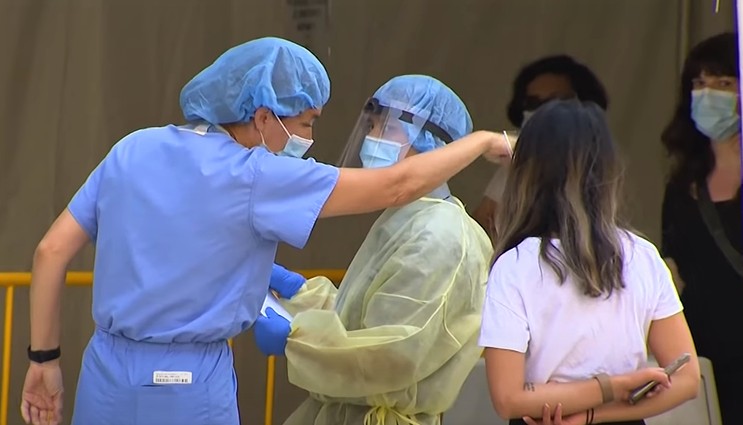
Brampton didn’t see a two week decline in COVID-19 cases, so why did it move to stage 2?
At the beginning of June, Brampton was identified as one of the province’s COVID-19 hotspots. Weeks later, despite no significant decline in new cases over two weeks, it was waved through to Stage 2 of Ontario’s reopening plan.
The move let Bramptonians live more freely. It allowed bars to open patios and hairdressers to begin taking appointments. Some beauticians got to work and malls were permitted to reopen. The public perception created by the second stage of reopening has led to gatherings across the province that violate ongoing measures to contain the spread of the novel coronavirus.
The province has repeatedly said reopening in stages will only happen if there is a consistent decline in new cases for a two to four week period. For the phase 2 reopening, Queen’s Park stated: “By grouping regions of the province by local public health units (PHUs), the government’s approach reflects the unique realities of different communities in Ontario, recognizing that many areas of the province have seen fewer or no new cases of COVID-19 in the past two weeks. Directed by the Province, each region will be permitted to enter Stage 2 when safe to do so.”
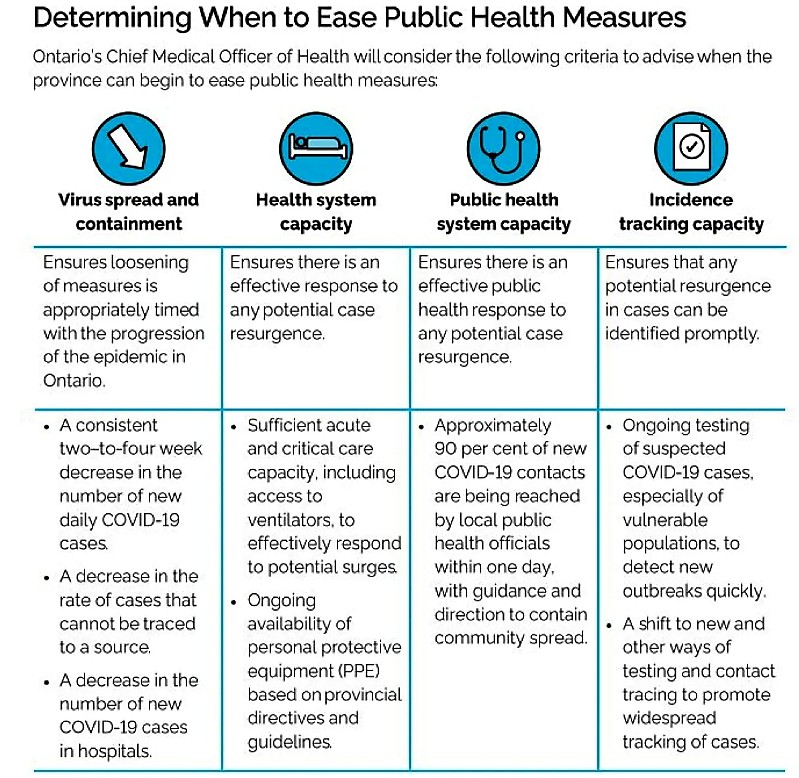
The Province's reopening guidelines have consistently stated a two week decline in new cases needs to be seen in communities before they can ease restrictions
Brampton moved into stage 2 on June 24, along with the rest of Peel, which had been held back because of the high rates of new cases that continued, unlike most of the rest of Ontario, which had progressed to stage 2 on June 19 (Toronto and Windsor-Essex were also held back).
The decision was made two days earlier, on June 22.
However, new COVID-19 numbers in Brampton for the two weeks prior to that date, raise questions about whether local public health officials are taking the advice of experts who have said that reopening should be based on the reality in each community. Is Brampton reopening because of lower numbers in Mississauga and Caledon, and could this lead to more problems in the country’s ninth largest city, if the transition is happening too early, before the local spread of the virus is adequately controlled?


Daily new case counts in Mississauga, top, are far lower over the past five weeks than in Brampton, bottom
There were 373 new cases in Brampton over the two weeks prior to the decision to move into stage 2, including June 22, with an average of 26.6 cases over those 14 days.
The following two days, including the 24th of June, when the city officially moved into stage 2, saw 25 new cases and 35 on the Friday that Brampton and the rest of Peel moved into stage 2.
Here are the daily new-case totals for Brampton from June 9 to June 24: 28, 25, 17, 19, 20, 24, 25, 22, 37, 41, 22, 26, 38, 29, 25, 35.
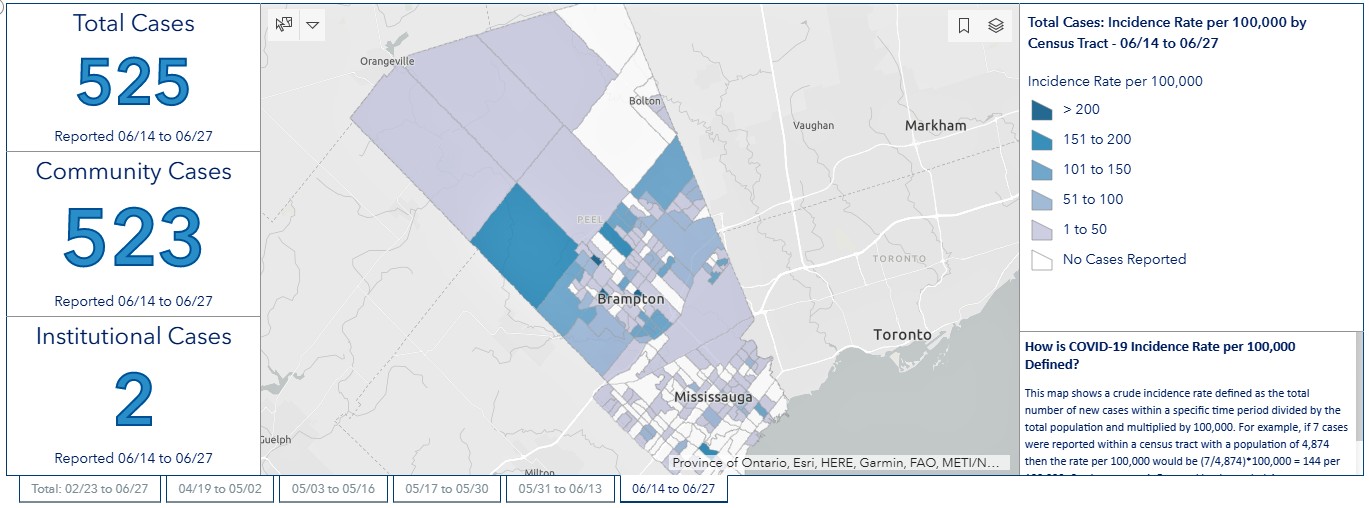
A neighbourhood map showing new cases from mid to late June, illustrates high rates of infection across Brampton, compared to most of the region
In Mississauga the numbers were much lower, averaging just 11.3 cases each day for the two weeks including June 22 when the stage 2 decision was made. So while Peel’s largest city had a new case rate of 2.1 infections per 10,000 residents over the two weeks to that date (based on a population of 750,000) Brampton’s rate over the same period was 5.7 new infections per 10,000 residents (based on a population of 650,000), almost three times the rate of its neighbour.
So why would public health officials make a decision to reopen both cities when one clearly was not ready?
“Peel Public Health supported the provincial decision to move the Region into Stage 2 on the basis of monitoring indicators (published weekly in our epidemiologic reports)...,” Dr Lawrence Loh, Peel’s top doctor whose approval was key to progress to Stage 2, explained by email to The Pointer on Friday.
“The Region had seen a consistent three week decline in its seven-day moving average of new cases from a peak of 70/day in early June to 40/day. This decline was observed and accounted for across all three area municipalities. Healthcare, testing, and tracing capacity was similarly at or near target, and this has also remained, which means a rapid response could be mounted to any observed increase in cases.”
He added that, with ramped up emergency responses and testing/tracing, he would not advise Peel to return to Stage 1 of shutdown. “The hope is that broader community closures will not be required going forward; rather closures will be more localized, targeted at facilities that see exposures and outbreaks as needed to protect the public,” he said.
However, epidemiological reports referenced by Loh leading up to (and after) Peel moved to Stage 2 do not appear to support a reopening, and certainly not for Brampton.
On June 12, just before the region was denied progress to Stage 2, Peel’s seven day moving average of cases and institutions in active COVID-19 outbreak were listed as “approaching target”; 88 percent of acute beds in the region were occupied, failing to meet their target, while testing and tracing statistics were marked as green and met the target to proceed.
The next week, the indicators had moved. The overall number of cases had met the target (for a seven day average), but institutions in outbreak had regressed from “approaching target” to “does not meet target”. Acute bed occupancy remained at 86 percent, not ready for Stage 2.
Still, Peel was given the green light to proceed.
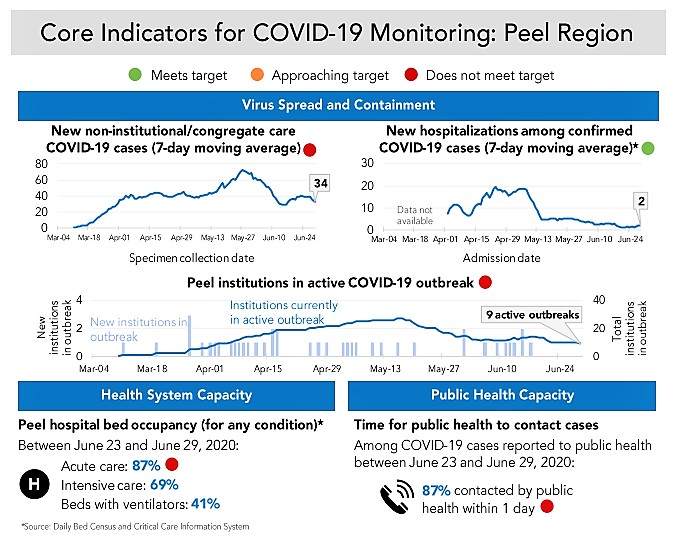
The Region's latest epidemiological report shows many key targets are not being met
By June 26, just two days after the region officially reopened, overall new cases had seen a spike. They regressed from hitting the target to no longer meeting it. Institutional outbreaks also failed to pass the test. Acute care beds sat at 87 percent occupancy, also too high to meet the target to move forward.
Despite the greenlight to open, few of the required benchmarks had been met and those that had appeared to be regressing.
“Through our discussions, my provincial counterparts reminded me of our province’s reopening framework that requires a community to see a minimum of a two week decline in new cases,” Loh said at a June 17 press conference with Mississauga Mayor Bonnie Crombie. “At the time of our discussion this weekend, that was still pending.”
Peel as a whole appears to have wobbled around the criteria to re-open, never quite hitting it conclusively. Brampton has not been close.
Analysis of the city’s new cases of COVID-19 shows that, by no measurement and at no point in June, did it achieve the minimum requirement of a two week decline in new cases outlined by Loh himself.
Consulting both the rolling seven day averages for Brampton each Friday and the daily case numbers reveals a city heading in the wrong direction almost throughout June. And the latest data from June 25 to July 5, which include the latest daily new cases counts for the city, show an average of 22.2 infections over the 12 days since the stage 2 decision was made on June 22, with a spike of 31 new cases on June 27 and 28 new infections on Friday, July 3.
Between May 30 and July 1, the most consecutive decreases in cases Brampton recorded was three days. On June 6 Brampton announced 35 new cases (four fewer than the day before) dropping to 31 the next day and 21 the following day. But, on June 9, the trend was broken and cases jumped back up to 28, peaking at 41 on June 18.
The rolling seven day average reflects a similar pattern. June 5 saw Brampton’s daily average at 39, dropping to 25 the following Friday. Those seven days represented the first half of a required two week decline. The following Friday, June 19, cases crept back up to an average of 27.3, something that should have reset the process.
Instead of waiting to see if cases would trend down again, Brampton seems to have piggybacked on Mississauga and Caledon, advancing to a more liberal reopening stage despite its persistent problems.
The following Friday, June 26, new COVID-19 positive results continued to go the wrong way, with the average climbing again. This time, the city averaged 29.7 new cases per day for the week.
As new cases did not decline in Brampton, the number of tests conducted in the city also lagged behind its target. Setting a conservative daily goal of 20,000 tests per day in Ontario (a number the province now regularly exceeds), Brampton should test about 950 people per day, based on a population of 650,000.
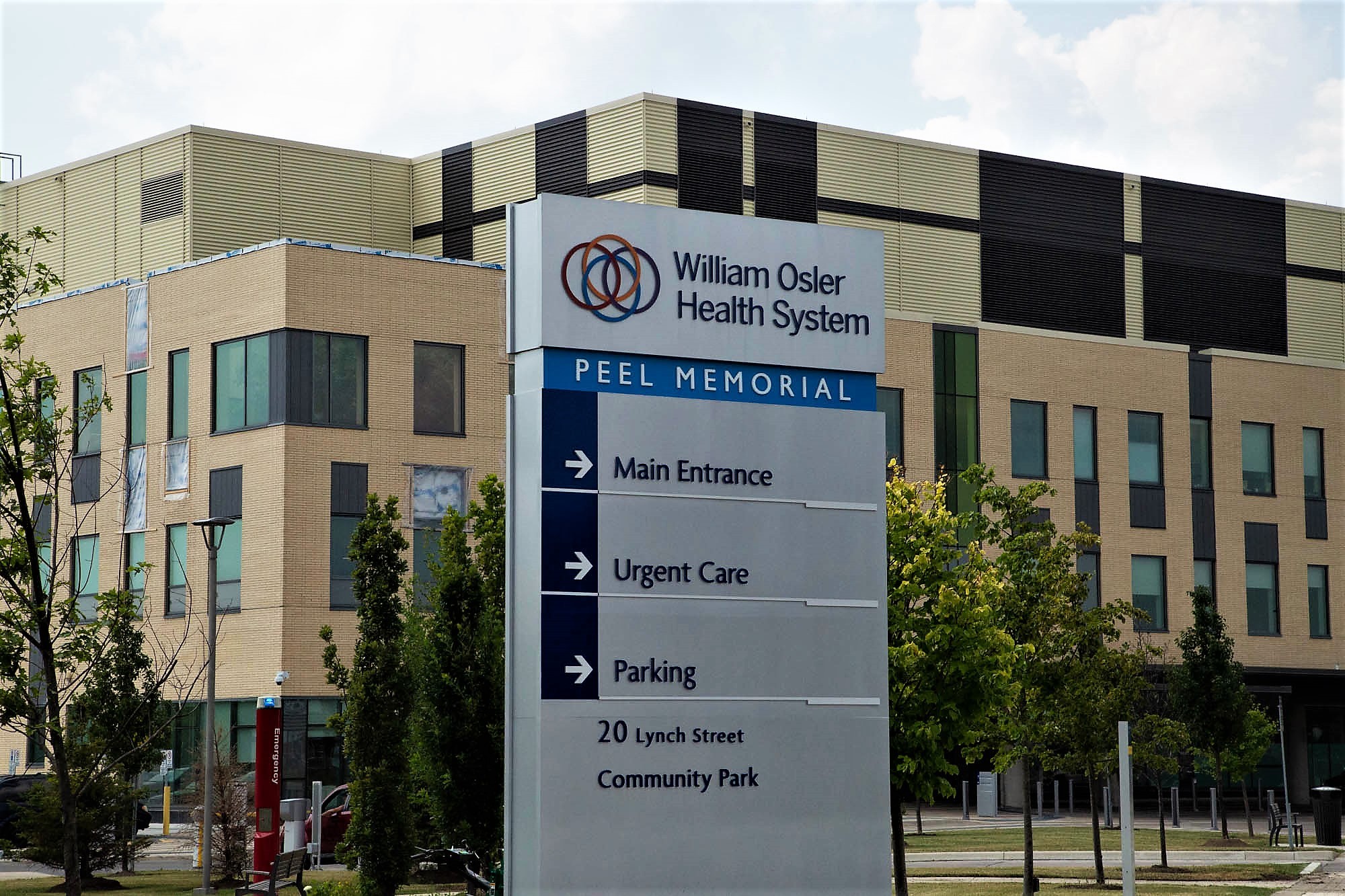
Data shared with The Pointer by William Osler, the hospital network responsible for the city’s testing, shows the city meeting a little more than half of that. Between June 16 and June 28, a total of 6,950 tests were completed in Brampton, while its per capita target based on the figure used by the province was 11,700 over that period.
Ontario has regularly exceeded 20,000 tests per day, over the past month, making Brampton’s numbers look even worse, comparatively. On June 20, Health Minister Christine Elliott tweeted that the province had processed more than 27,000 tests the day before, a record at the time. Per-capita, Brampton should have contributed about 1,250 of them, but instead managed less than half, at 531 on that particular day.
The province last month announced it was sending in help to communities that were performing poorly on testing, and shortly after set up a pop-up screening centre in Brampton for a day, with more such emergency measures to help the struggling city.
In the face of this inadequate testing in one of the province’s COVID-19 hotspots, Brampton Mayor Patrick Brown attempted to inflate figures for his city. The mayor included tests completed by Osler in its two Etobicoke facilities, suggesting they were done in Brampton.
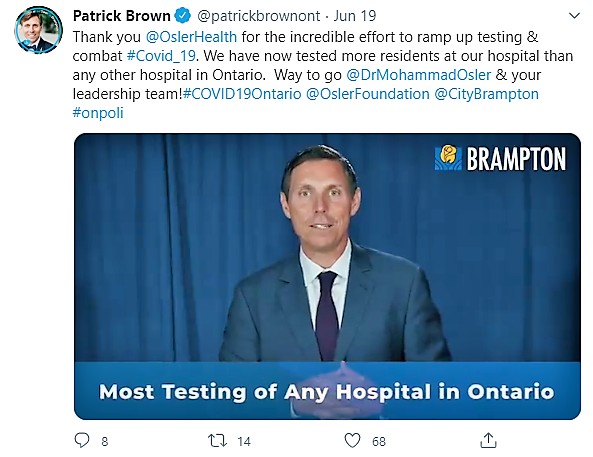
“We have now tested more people in our hospital than anywhere else in the province, the number one testing hospital in Ontario is our very own William Osler Health System,” Brown said in a video posted to his Twitter account on June 19.
On the video, as he said the words, text flashes below the mayor: “52,000 Tests”. He also said Brampton and Ottawa had done more testing than any other cities in Ontario. Brown’s claims were blatantly misleading. The number he used was not for Brampton alone, but the total testing done by the William Osler Health System across its three screening sites, only one of which is in Brampton. The other two are in Etobicoke.
The danger of misrepresenting testing, even to improve morale after months of residents staying at home, is it can create complacency. When Brampton residents believe they are the most tested city in Ontario, they might be less likely to seek a test themselves.
As of June 28, Osler had tested 65,000 people for COVID-19; 27,700 of those tests took place in Brampton. The figures represent a significant increase in recent weeks, but still not even half the number that had been claimed by Brown at the time he used the misleading figures.
Previously, Premier Doug Ford blasted communities for failing to meet testing targets and shortly after, his government sent the pop-up help for Brampton.
It’s unclear why Osler has operated two testing facilities throughout the pandemic in Etobicoke but only one in Brampton. Etobicoke’s population is about 60 percent of its neighbour to the west.
Meanwhile, despite low testing figures and high rates of new infections, Brampton enjoys the same reopening privileges as other parts of the province where there are few to no new cases.
The danger of proceeding to Stage 2 of reopening with a troubling rolling average and inadequate testing is demonstrated by the City of Kingston. As early as May 9, Kingston was declared COVID-19 free and allowed to move to Stage 2 on June 12.
But since reopening, a small spike in cases has been linked to nail salons in the city, according to media reports. Following recent outbreaks, associated with certain personal care salon businesses, Kingston has 33 active cases.
Kingston is light years ahead of Brampton in its response to COVID-19 and heralded as a rare success story in the province’s battle against the virus. Flare ups in cases linked to Stage 2 reopenings in a city so far ahead of Brampton do not bode well.
Email: [email protected]
Twitter: @isaaccallan
Tel: 647 561-4879
COVID-19 is impacting all Canadians. At a time when vital public information is needed by everyone, The Pointer has taken down our paywall on all stories relating to the pandemic and those of public interest to ensure every resident of Brampton and Mississauga has access to the facts. For those who are able, we encourage you to consider a subscription. This will help us report on important public interest issues the community needs to know about now more than ever. You can register for a 30-day free trial HERE. Thereafter, The Pointer will charge $10 a month and you can cancel any time right on the website. Thank you.
Submit a correction about this story


